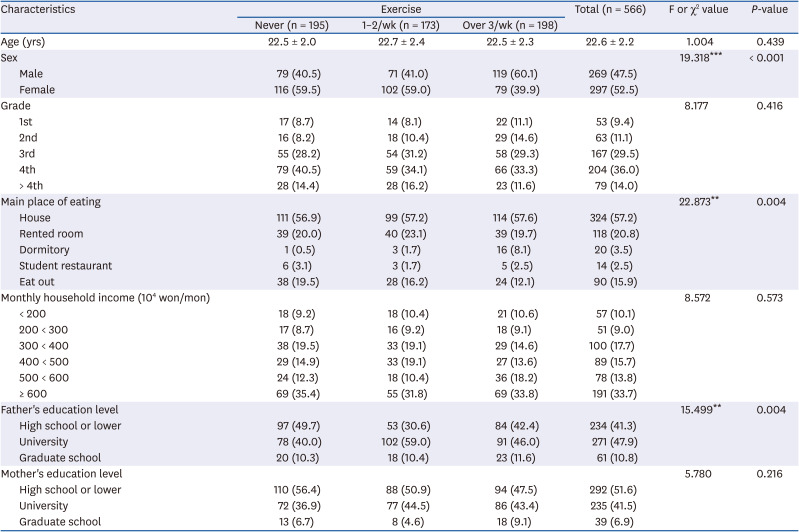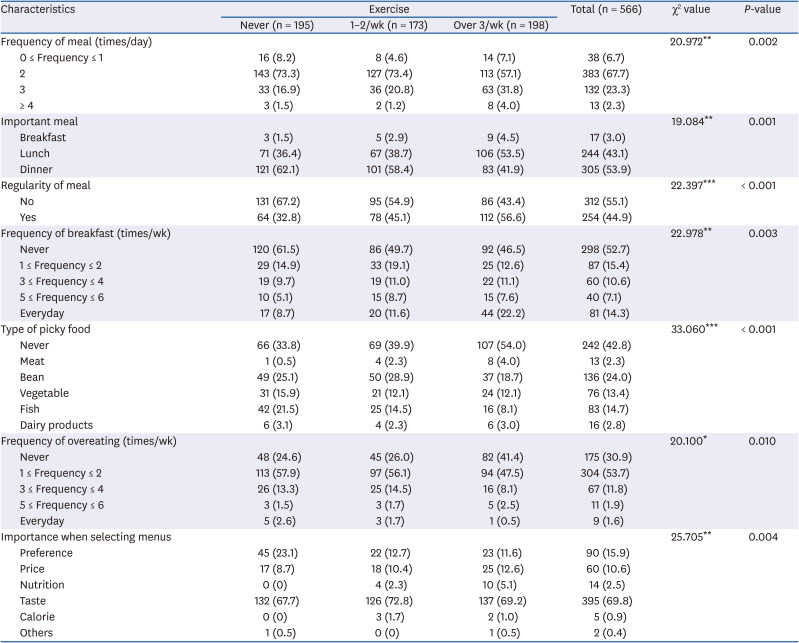1. Park ST. Differences between body composition, physical self-efficacy and stress according to the physical activity of female college students. Korean J Teach Educ. 2019; 35:381–392.
2. Yang DI, Suk MH, Lim KI, Shin YA. Comparison of physical activity and health fitness in adults with and without intellectual disability. Korean J Adapt Phys Act. 2014; 22:99–117.
3. Hwang EJ, Hong JY, Park JK, Kim JE, Kim SW, Kong HJ. Comparisons of cardiovascular disease risk factors and sarcopenia-related factors according to physical activity levels in basic livelihood security recipient elderly women. J Digit Policy Manag. 2013; 11:507–516.
4. Choi BB. Recognition and consumption of meal alone and processed food according to major of college students. Korean J Food Nutr. 2016; 29:911–922.

5. Lee JS, Oh HK, Choi KS. A study on utilization of processed foods and recognition of food labels among university students. Korean J Food Nutr. 2015; 28:24–33.

6. Lee YS, Oh SY, Kim GW. Analysis on the health condition, meal type and snack preference of university students in Chungnam province. Korean J Hum Ecol. 2010; 19:409–416.

7. Park EO. The prevalence of metabolic syndrome and its components, and the related health behavior among adults over 20 years old in Jeju, South Korea. Asia Pac J Multimed Serv Converg Art Humanit Sociol. 2015; 5:91–98.

8. Kim M. The effects of life stress and circadian rhythm on depression in college students. J Digit Converg. 2017; 15:247–257.
9. Seo BK, Cha SS. The effects of depression of university students on smartphone dependence: focusing on the mediating effect of self-efficacy. J Korea Contents Assoc. 2020; 20:478–486.
10. Kim MS, Kim JI. Relationship among the health state, daily living activities (ADL, IADL), sleep state, and depression among old people at elderly care facilities. J Korean Acad Ind Soc. 2015; 16:2609–2619.

11. Sung JM, Bang GH, Kong MA, Kim JS, Kang HS. The effects of aerobic exercise on blood lipids, stress and growth hormones of middle-aged women based on NaB golf training. Exerc Sci. 2012; 21:445–454.
12. Kim SY, Seo YJ, Kim MH, Choi MK. Eating habit and stress status according to exercising habits of middle-aged adults in Chungnam. Korean J Food Nutr. 2016; 29:43–51.

13. Ministry of Health and Welfare (KR). National Health and Nutrition Survey Report. Sejong: Ministry of Health and Welfare;2010.
14. Kim NH. Food habits, health behaviors, and dietary pattern according to the personality in Korean college students [master's thesis]. Seongnam: Gachon University;2019.
15. Cho MJ, Kim KH. Diagnostic validity of the CES-D (Korean version) in the assessment of DSM-III-R major depression. J Korean Neuropsychiatr Assoc. 1993; 32:381–399.
16. Choi IS, Ro HK. A comparison study on middle school students of Gwangju and Jeonnam in terms of dietary behavior, body perception and weight control concerns according to BMI. J Korean Soc Food Sci Nutr. 2010; 39:383–391.

17. Chin JH, Chang KJ. College student's attitude toward body weight control, health-related lifestyle and dietary behavior by self-perception on body image and obesity index. J Korean Soc Food Sci Nutr. 2005; 34:1559–1565.
18. Jung SB, Cheon GS. A study on health-related behaviors and dietary habits and nutrient intake according to exercise in college students. J Korean Data Anal Soc. 2009; 11:229–240.
19. Kim EH, Lee HY. Job stress and psychosocial health according to the level of exercise behavior of working women. Official J Korean Acad Kinesiol. 2013; 15:49–59.
20. Shin YJ, Ju MJ, Kim YH. Eating behaviors and nutritional status according to the purpose of exercise. J Korean Soc Food Sci Nutr. 2013; 42:904–910.

21. Chung KH, Shin KO, Choi KS, Yoo KW, Yoo JH. A study on dietary behaviors, and the health of male adults according to their exercising habits. Korean J Food Nutr. 2013; 26:329–338.

22. Ko DS, Ryu SY, Jung DI, Kim MJ, Kim YN, Park J. Differences between depression and life stress in exercise behavior change stage of some female college students. J Digit Policy Manag. 2013; 11:395–404.
23. Lee JS, Kim MH, Bae YJ, Choe YH, Sung CJ. A study of dietary habits, nutrition intake status and serum copper and zinc concentrations of adolescent athletes. Korean J Nutr. 2005; 38:465–474.
24. Lee JE. A survey on intake of protein supplement of university students majoring in physical education. J Korean Soc Food Sci Nutr. 2014; 43:1607–1613.

25. Kim JS, Jung DS, Park DH. A survey of ergogenic aids supplementation in elite bodybuilder. Korean J Sport Sci. 2012; 23:155–166.
26. Kim SY, You JS, Chang KJ. Consumption of health functional food and dietary habits, nutrient intake and dietary quality of college students in Incheon. Korean J Nutr. 2013; 46:166–176.

27. Rho JO. A study on dietary behavior and health-related lifestyles according to exercise habits of female university students in the Jeonju area. J East Asian Soc Diet Life. 2007; 17:607–614.
28. Jeon YN, Park JJ, Yang JH. Effects of exercise on the health-related fitness, postpartum depression and body weight in puerperium period during pregnancy. Official J Korean Acad Kinesiol. 2013; 15:123–130.
29. Woo KH, Yang JO, Lee JS, Lee BJ, Kim ES, Jung SH, Kwak YS. Effects of the upright body type exercise on lung capacity and depression of people with mental illness. J Life Sci. 2016; 26:1169–1181.
30. Kim ML, Song KY. Changes of the level of physical self-efficacy, depression and stress of middle-aged men according to the stage of exercise change. J Korea Contents Assoc. 2009; 9:393–402.

31. Choi JW, Chun MU, Kang SG. Cognitive function, depression and quality of life according to the demographic characteristics and physical activity type of the elderly. J Korea Converg Soc. 2017; 8:431–444.










 PDF
PDF Citation
Citation Print
Print



 XML Download
XML Download